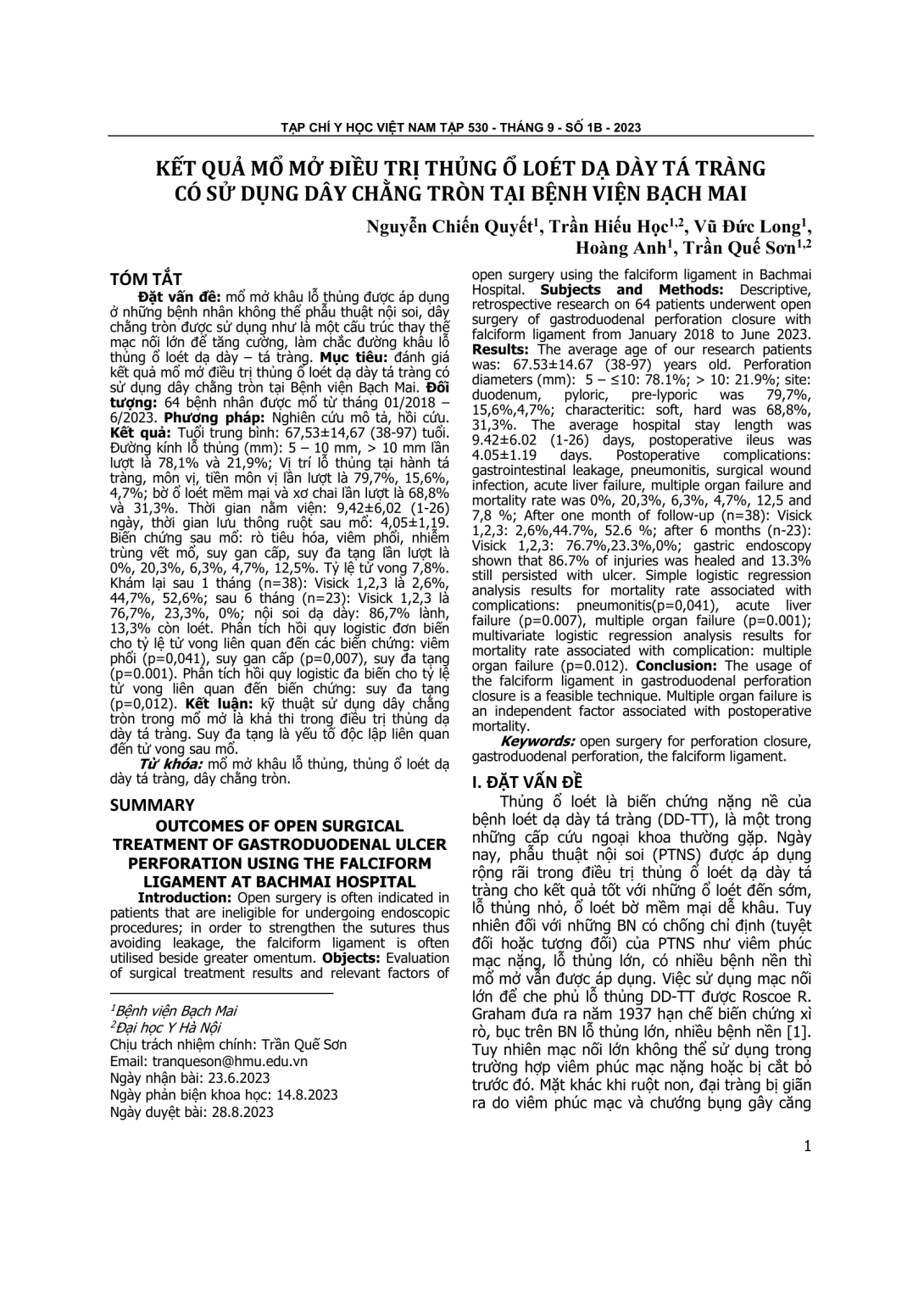
Mổ mở khâu lỗ thủng được áp dụng ở những bệnh nhân không thể phẫu thuật nội soi, dây chằng tròn được sử dụng như là một cấu trúc thay thế mạc nối lớn để tăng cường, làm chắc đường khâu lỗ thủng ổ loét dạ dày – tá tràng. Mục tiêu: đánh giá kết quả mổ mở điều trị thủng ổ loét dạ dày tá tràng có sử dụng dây chằng tròn tại Bệnh viện Bạch Mai. Đối tượng: 64 bệnh nhân được mổ từ tháng 01/2018 – 6/2023. Phương pháp: Nghiên cứu mô tả, hồi cứu. Kết quả: Tuổi trung bình: 67,53±14,67 (38-97) tuổi. Đường kính lỗ thủng (mm): 5 – 10 mm, > 10 mm lần lượt là 78,1% và 21,9%; Vị trí lỗ thủng tại hành tá tràng, môn vị, tiền môn vị lần lượt là 79,7%, 15,6%, 4,7%; bờ ổ loét mềm mại và xơ chai lần lượt là 68,8% và 31,3%. Thời gian nằm viện: 9,42±6,02 (1-26) ngày, thời gian lưu thông ruột sau mổ: 4,05±1,19. Biến chứng sau mổ: rò tiêu hóa, viêm phổi, nhiễm trùng vết mổ, suy gan cấp, suy đa tạng lần lượt là 0%, 20,3%, 6,3%, 4,7%, 12,5%. Tỷ lệ tử vong 7,8%. Khám lại sau 1 tháng (n=38): Visick 1,2,3 là 2,6%, 44,7%, 52,6%; sau 6 tháng (n=23): Visick 1,2,3 là 76,7%, 23,3%, 0%; nội soi dạ dày: 86,7% lành, 13,3% còn loét. Phân tích hồi quy logistic đơn biến cho tỷ lệ tử vong liên quan đến các biến chứng: viêm phổi (p=0,041), suy gan cấp (p=0,007), suy đa tạng (p=0.001). Phân tích hồi quy logistic đa biến cho tỷ lệ tử vong liên quan đến biến chứng: suy đa tạng (p=0,012). Kết luận: kỹ thuật sử dụng dây chằng tròn trong mổ mở là khả thi trong điều trị thủng dạ dày tá tràng. Suy đa tạng là yếu tố độc lập liên quan đến tử vong sau mổ.
Open surgery is often indicated in patients that are ineligible for undergoing endoscopic procedures; in order to strengthen the sutures thus avoiding leakage, the falciform ligament is often utilised beside greater omentum. Objects: Evaluation of surgical treatment results and relevant factors of open surgery using the falciform ligament in Bachmai Hospital. Subjects and Methods: Descriptive, retrospective research on 64 patients underwent open surgery of gastroduodenal perforation closure with falciform ligament from January 2018 to June 2023. Results: The average age of our research patients was: 67.53±14.67 (38-97) years old. Perforation diameters (mm): 5 – ≤10: 78.1%; > 10: 21.9%; site: duodenum, pyloric, pre-lyporic was 79,7%, 15,6%,4,7%; characteritic: soft, hard was 68,8%, 31,3%. The average hospital stay length was 9.42±6.02 (1-26) days, postoperative ileus was 4.05±1.19 days. Postoperative complications: gastrointestinal leakage, pneumonitis, surgical wound infection, acute liver failure, multiple organ failure and mortality rate was 0%, 20,3%, 6,3%, 4,7%, 12,5 and 7,8 %; After one month of follow-up (n=38): Visick 1,2,3: 2,6%,44.7%, 52.6 %; after 6 months (n-23): Visick 1,2,3: 76.7%,23.3%,0%; gastric endoscopy shown that 86.7% of injuries was healed and 13.3% still persisted with ulcer. Simple logistic regression analysis results for mortality rate associated with complications: pneumonitis(p=0,041), acute liver failure (p=0.007), multiple organ failure (p=0.001); multivariate logistic regression analysis results for mortality rate associated with complication: multiple organ failure (p=0.012). Conclusion: The usage of the falciform ligament in gastroduodenal perforation closure is a feasible technique. Multiple organ failure is an independent factor associated with postoperative mortality.
- Đăng nhập để gửi ý kiến
